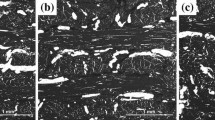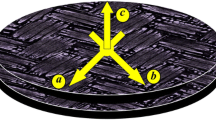Abstract
Mesophase pitch-based large-diameter fibers were used to prepare unidirectional carbon/carbon (C/C) composite blocks, and mesophase pitch incorporated by various carbonaceous fillers was selected as a modified binder. The C/C composites were produced through a hot-pressing method, followed by carbonization and graphitization treatments. The influence of the carbonaceous fillers on the microstructure and physical properties of the C/C composites in different directions was investigated. The results show that both filler type and volume fraction have an important effect on the directional thermal conductivity of resulting composites. The through-thickness thermal conductivity of composites is significantly improved to be as high as 40–60 W/m K due to the incorporation of some carbonaceous dopants, which can tune their thermal conduction performance in different directions and thus solve the limitation of one-directional high thermal conduction. A three-dimensional carbon-based conductive network is diagramed to illustrate the thermal conduction mechanism of various carbon materials. The reinforcing effect on the directional thermal conductivity depends on the geometrical and physical characteristics, volume fractions and spatially distributed status of carbonaceous fillers. The flexural strengths of the composites are obviously improved owing to the decrease in porosity in the composites and the enhanced interfacial interaction between the carbon fibers and pitch-derived carbon matrix by doping with natural graphite flakes or carbon nanotubes.















Similar content being viewed by others
References
Luedtke A (2004) Thermal management materials for high performance applications. Adv Eng Mater 6(3):142–144
Zweben C (1998) Advances in composite materials for thermal management in electronic packaging. JOM 50(6):47–51
Shindé SL, Goela JS (2006) High thermal conductivity materials. Springer, New York
Hong H, Kim JU, Kim T (2017) Effective assembly of nano-ceramic materials for high and anisotropic thermal conductivity in a polymer composite. Polymers 9(9):413
Feng W, Qin MM, Feng YY (2016) Toward highly thermally conductive all-carbon composites: structure control. Carbon 109:575–597
Hong H, Jung YH, Lee JS, Jeong C, Kim JU, Lee S, Ryu H, Kim H et al (2019) Anisotropic thermal conductive composite by the guided assembly of boron nitride nanosheets for flexible and stretchable electronics. Adv Funct Mater 29(37):1902575
Wang YY, Guo QQ, Su GH, Cao J, Liu JZ, Zhang XX (2019) Hierarchically structured self-healing actuators with superfast light- and magnetic-response. Adv Funct Mater 29(50):1906198
Sheehan JE, Buesking KW, Sullivan BJ (1994) Carbon–carbon composites. Annu Rev Mater Sci 24:19–44
Fitzer E (1987) The future of carbon–carbon composites. Carbon 25(2):163–190
Kude Y, Sohda Y (1996) Thermal management of carbon–carbon composites by functionally graded fiber arrangement technique. In: Shiota I, Miyamoto Y (eds) Functionally graded materials. Elsevier, Oxford, pp 239–244
Chung DDL (1994) Carbon fiber composites. Butterworth-Heinemann, Newton
Lackey WJ (2001) Carbon–carbon composites. In: Buschow KHJ, Cahn RW, Flemings MC, Iischner B, Kramer EJ, Mahajan S, Veyssière P (eds) Encyclopedia of materials: science and technology. Pergamon Press, London, pp 952–967
Manocha LM, Warrier A, Manocha S, Sathiyamoorthy D, Banerjee S (2006) Thermophysical properties of densified pitch based carbon/carbon materials-I. Unidirectional composites. Carbon 44(3):480–487
Li TQ, Xu ZH, Hu ZJ, Yang XG (2010) Application of a high thermal conductivity C/C composite in a heat-redistribution thermal protection system. Carbon 48(3):924–925
Edie DD, Robinson KE, Fleurot O, Jones SP, Fain CC (1994) High thermal conductivity ribbon fibers from naphthalene-based mesophase. Carbon 32(6):1045–1054
Minus ML, Kumar S (2005) The processing, properties, and structure of carbon fibers. JOM 57(2):52–58
Emmerich FG (2014) Young’s modulus, thermal conductivity, electrical resistivity and coefficient of thermal expansion of mesophase pitch-based carbons fibers. Carbon 68:274–293
Bowers DA, Davis JW, Dinwiddie RB (1994) Development of 1-D carbon composites for plasma-facing components. J Nucl Mater 212–215:1163–1167
Golecki I, Xue L, Leung R, Walker T, Anderson A, Dewar D, Duncan C, Horik JV (1998) Properties of high thermal conductivity carbon–carbon composites for thermal management applications. In: High-temperature electronic materials, devices and sensors conference. San Diego, February, pp 190–195
Snead LL, Burchell TD (1995) Thermal conductivity degradation of graphites due to nuetron irradiation at low temperature. J Nucl Mater 224:222–229
Bonal JP, Wu CH (1996) Neutron irradiation effects on the thermal conductivity and dimensional stability of carbon fiber composites at divertor conditions. J Nucl Mater 228:155–161
Adams PM, Katzman HA, Rellick GS, Stupian GW (1998) Characterization of high thermal conductivity carbon fibers and a self-reinforced graphite panel. Carbon 36(3):233–245
Ma ZK, Shi JL, Song Y, Guo QG, Zhai GT, Liu L (2006) Carbon with high thermal conductivity, prepared from ribbon-shaped mesophase pitch-based fibers. Carbon 44(7):1298–1301
Ma ZK, Liu L, Lian F, Song HH, Liu J (2012) Three-dimensional thermal conductive behavior of graphite materials sintered from ribbon mesophase pitch-based fibers. Mater Lett 66(1):99–101
Lin JF, Yuan GM, Li XK, Dong ZJ, Zhang J, Zhang ZW, Wang JS (2013) Preparation of 1D C/C Composites with high thermal conductivity. J Inorg Mater 28(12):1338–1344
Yuan GM, Li XK, Dong ZJ, Xiong XQ, Rand B, Cui ZW, Cong Y, Zhang J et al (2014) Pitch-based ribbon-shaped carbon-fiber-reinforced one-dimensional carbon/carbon composites with ultrahigh thermal conductivity. Carbon 68:413–425
Zhang X, Li XK, Yuan GM, Dong ZJ, Ma GZ, Rand B (2017) Large diameter pitch-based graphite fiber reinforced unidirectional carbon/carbon composites with high thermal conductivity densified by chemical vapor infiltration. Carbon 114:59–69
Yuan GM, Li XK, Dong ZJ, Westwood A, Rand B, Cui ZW, Cong Y, Zhang J et al (2014) The structure and properties of ribbon-shaped carbon fibers with high orientation. Carbon 68:426–439
Yuan GM, Li BL, Li XK, Dong ZJ, Hu WJ, Westwood A, Cong Y, Zhang J (2019) Effect of liquid crystalline texture of mesophase pitches on the structure and property of large diameter carbon fibers. ACS Omega 4(1):1095–1102
Yuan GM, Li XK, Xiong XQ, Dong ZJ, Westwood A, Li BL, Ye C, Ma GZ (2017) A comprehensive study on the oxidative stabilization of mesophase pitch-based tape-shaped thick fibers with oxygen. Carbon 115:59–76
Yuan GM, Li XK, Yi J, Dong ZJ, Westwood A, Li BL, Cui ZW, Cong Y et al (2015) Mesophase pitch-based graphite fiber-reinforced acrylonitrile butadiene styrene resin composites with high thermal conductivity. Carbon 95:1007–1019
Li XK, Yuan GM, Westwood A, Zhang HB, Dong ZJ, Brown A, Brydson R (2008) The preparation and CVD densification of multi-walled carbon nanotube felt synthesised by a catalytic CVD method. Chem Vap Depos 14(1–2):40–45
Yuan GM, Li XK, Dong ZJ, Westwood A, Cui ZW, Cong Y, Du HD, Kang FY (2012) Graphite blocks with preferred orientation and high thermal conductivity. Carbon 50(1):175–182
Marsh H, Diez MA (1994) Mesophase of graphitizable carbons. In: Shibaev VP, Lam L (eds) Liquid crystalline and mesomorphic polymers. Springer, New York, pp 231–257
Mochida I, Korai Y, Ku CH, Watanabe F, Sakai Y (2000) Chemistry of synthesis, structure, preparation and application of aromatic-derived mesophase pitch. Carbon 38(2):305–328
Zimmer JE, White JL (1983) Mesophase alignment within carbon fiber bundles. Carbon 21(3):323–324
Rand B (2005) Composites: carbon matrix. In: Bassani F, Liedl GL, Wyder P (eds) Encyclopedia of condensed matter physics. Elsevier, Oxford, pp 178–192
Menéndez R, Granda M, Fernández JJ, Figueiras A, Bermejo J, Bonhomme J, Belzunce J (1997) Influence of pitch air-blowing and thermal treatment on the microstructure and mechanical properties of carbon/carbon composites. J Microsc 185(2):146–156
Blanco C, Appleyard SP, Rand B (2002) Study of carbon fibres and carbon–carbon composites by scanning thermal microscopy. J Microsc 205(1):21–32
Hishiyama Y, Nakamura M (1995) X-ray diffraction in oriented carbon films with turbostratic structure. Carbon 33(10):1399–1403
Feng W, Qin MM, Lv P, Li JP, Feng YY (2014) A three-dimensional nanostructure of graphite intercalated by carbon nanotubes with high cross-plane thermal conductivity and bending strength. Carbon 77:1054–1064
Chen SC, Feng YY, Qin MM, Ji TX, Feng W (2017) Improving thermal conductivity in the through-thickness direction of carbon fibre/SiC composites by growing vertically aligned carbon nanotubes. Carbon 116:84–93
Lv F, Qin MM, Zhang F, Yu HT, Gao L, Lv P, Wei W, Feng YY et al (2019) High cross-plane thermally conductive hierarchical composite using graphene-coated vertically aligned carbon nanotubes/graphite. Carbon 149:281–289
Zhang SD, Gao L, Han JC, Li ZX, Zu GQ, Ran X, Sun YG (2019) Through-thickness thermal conductivity enhancement and tensile response of carbon fiber-reinforced polymer composites. Compos Part B Eng 165:183–192
Huang HS, Ganguli S, Roy AK (2013) Prediction of the transverse thermal conductivity of pitch-based carbon fibers. J Compos Mater 48(11):1383–1390
Alway-Cooper RM, Theodore M, Anderson DP, Ogale AA (2012) Transient heat flow in unidirectional fiber–polymer composites during laser flash analysis: experimental measurements and finite element modeling. J Compos Mater 47(19):2399–2411
Sung DH, Kim M, Park YB (2018) Prediction of thermal conductivities of carbon-containing fiber-reinforced and multiscale hybrid composites. Compos Part B Eng 133:232–239
Macias JD, Bante-Guerra J, Cervantes-Alvarez F, Rodrìguez-Gattorno G, Arés-Muzio O, Romero-Paredes H, Arancibia-Bulnes CA, Ramos-Sánchez V et al (2019) Thermal characterization of carbon fiber-reinforced carbon composites. Appl Compos Mater 26(1):321–337
Lee YS, Lee SY, Kim KS, Noda S, Shim SE, Yang CM (2019) Effective heat transfer pathways of thermally conductive networks formed by one-dimensional carbon materials with different sizes. Polymers 11(10):1661
Kelly BT (1968) Theory of the effect of crystallite boundaries on the principal thermal conductivities of highly oriented graphite. Carbon 6(1):71–80
Acknowledgements
This work was sponsored by the National Natural Science Foundation of China (Grant Nos. 51372177, U1960106), the Key Laboratory of Hubei Province for Coal Conversion and New Carbon Materials (Grant No. WKDM201701) and the China Scholarship Council Fund (201808420114).
Author information
Authors and Affiliations
Corresponding authors
Ethics declarations
Conflict of interest
The authors declare that no conflict of interest exists.
Additional information
Publisher's Note
Springer Nature remains neutral with regard to jurisdictional claims in published maps and institutional affiliations.
Rights and permissions
About this article
Cite this article
Yuan, G., Li, Y., Long, X. et al. Tuning anisotropic thermal conductivity of unidirectional carbon/carbon composites by incorporating carbonaceous fillers. J Mater Sci 55, 5079–5098 (2020). https://doi.org/10.1007/s10853-020-04357-4
Received:
Accepted:
Published:
Issue Date:
DOI: https://doi.org/10.1007/s10853-020-04357-4




